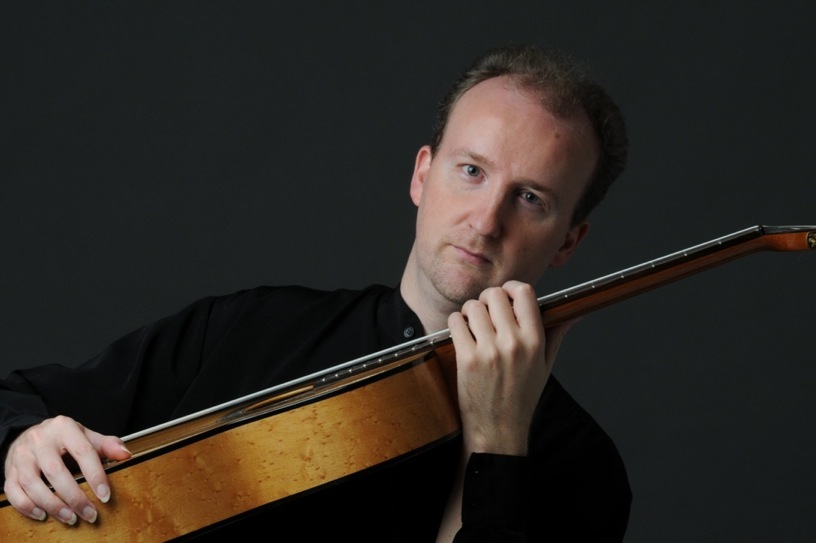Paolo Pegoraro guitar
Artistic director and sound engeneer: Paolo Pegoraro
Recording: Chiesa di S. Simone - Prata di Pordenone - 19/22 September 2009
Editing - Mastering: Alessandro Simonetto
Artwork: Angelica Santarossa
Photo Paolo Pegoraro: Michela Cecchin - L'immagine fotografia (Pordenone)
Guitar: Luca Waldner n° 100 - 2008
"The narration of a story! Trying not to over emphasize the plot, displaying a faithful representation of the characters and their psychology, yet becoming one with their deepest emotions.\"
What I try to achieve through my interpretations is to use sound as an element filtered through my personality, imagination and experience, striving to explore unbeaten paths.
As for my previous CD, "Solo", this last recording is a compilation of works which I am particularly fond of and in which I purposed to record my artistic development at this specific point of time.
The comprehensive project that I will develop with FaraRecords, foreshadows further monographic programs linked to carefully selected authors, historic periods or musical forms.
The research carried out for the sound recording aims to a faithful reproduction of the instrument's authentic voice, as listened to in a concert hall.
The choice of the guitar, a Luca Waldner in spruce and maple, was significant for me; in it I found a balanced and cantabile sound, a variety of tones and nuances, which gave an immense contribution to my self-expression.
I dedicate this work to my students from the past, the present and those yet to be, because I feel they play a highly significant part in my life, as a man and a musician.
Paolo Pegoraro
(Translation: Svanhildur Rósa Pálmadóttir)
Programme notes
The fiery rasgueados of the Fantasia Sevillana op. 29 by Joaquín Turina (Seville 1882 - Madrid 1949) open, with great energy, the programme proposed in this Cd. His Sevillana, so evocative of his native land, introduces at once subtle impressionistic and romantic reminiscences, but also some discordances: it was only in 1923 that the composer wrote this piece in Madrid, a good ten years after his return from Paris where he had gone, still a student, to take lessons in composition with Vincent d\'Indy. The composer's musical language was again imbued with a marked Andalusian sensitivity, the same sensitivity that, revisited under the influence of the new atmosphere assimilated during the period of his viaje (journey) to France, inspired the impassioned Fantasia. However, let us allow the words that Turina himself dedicated to his dear friend Manuel de Falla to explain to us the sentiment of both composers: "It was in Paris that the great musician was formed. This important phase determined the perfecting of his technique and the real beginning of his production The intense musical life of the great city, the clash between the different trends and ideals, the great figures in one field or another, Fauré and d'Indy, Debussy and Ravel and Albéniz's Spanish campaign, everything formed part of a very attractive musical environment, of great power. Perhaps he would never have left Paris if the war of 1912 had not driven everyone out". It was, however, the meeting with Albéniz that was to cause in the young Joaquín that deep inner transformation that made him return to his roots. Although the lessons taken at the Schola Cantorum had eased his homesickness a little, Albéniz's strong nationalist call now finally convinced the composer that " we were three Spaniards, in that circle, in a corner of Paris, that had to make great efforts for our national music and for Spain."
The true importance of Miguel Llobet Soles (Barcellona 1878 - 1938) undoubtedly greatly exceeds that of the mere virtuoso concert-player, in spite of being rightly remembered in various documents of the time for his sublime, highly expressive way of playing the guitar, as recordings, -very probably the first in the history of his instrument,- also testify. Llobet's historical position allowed him to play a fundamental role in the development of the modern Spanish guitar, still fresh from the important innovations carried out by the luthier Antonio Torres. Suffice it to say that he was the highly-valued vehicle through which Francisco Tárrega's technical-interpretative school was handed down to new generations. Lastly, the figures of Tárrega and Llobet can be linked together through the notable work they both dedicated to extending the catalogue of works for the guitar. In fact, the two musicians enriched their concert repertoire with their own compositions -those of Tárrega greatly exceeding in number those of his pupil, who dedicated much of his energy to rewriting for the guitar several works by the Catalan Maestros of the piano such as Granados and Albéniz-. The three pieces presented reveal the masterly hand of Llobet the transcriber. The Leonesa is an arrangement of a ballade from the León region, while El Testament d'Amèlia and the Cançó del Lladre are adaptations for guitar of the homonymous Canciones Populares Catalanas. The transcriptions denote an extremely high artistic level and reveal the intention of the composer to carry out an extensive exploration of the colour and timbre of the instrument, at times applying different techniques such as the use of harmonics. These pieces are certainly proof that Llobet was not immune to Catalan Modernism, an artistic movement straddling two centuries, that permitted Barcellona and its artists look to Europe. It was, therefore, through the filter of French Impressionism that the guitarist, emigrant to Paris, returned to the bosom of his homeland and its folk songs.
Although Manuel María Ponce Cuéllar (Fresnillo 1882 - Mexico City 1948) was at forty years old already considered a successful composer, an event had still to take place that was to leave a profound mark on his artistic growth: the encounter in 1923 with Andrés Segovia. In fact, it was this felicitous meeting, which happened during a tour by the Spanish guitarist in Mexico, that marked the beginning of a very long relationship both of close friendship and collaboration leading to the birth of some of the most important works in the guitar repertoire of the Twentieth Century. In 1925, Ponce made a second journey to Europe; this time, however, to Paris to study composition with Paul Dukas at the prestigious Ecole Normal. The French capital was then a lively meeting-place for artists from all over the world and the pilgrimage destination for every composer. In this way, Ponce was able to meet some of the most important followers at the service of the musical revolution initiated by Segovia. Included among these illustrious names are Rodrigo, de Falla, Turina and Villa-Lobos. It was in Paris, in 1927, that the Sonata No. III originated, as a continuation to the little-appreciated second sonata (today missing) in which Ponce probably renewed the language in a way that failed to entirely convince Segovia. The composer consequently wrote the third sonata using, in fact, a more modern language, without, however, offending the Spanish guitarist's taste. The piece is in three movements: the first is an Allegro moderato in sonata form, the style of which ranges from the Chopinesque neo-romanticism to an idiomatic use of chords in fourths. The second movement is an Andante whose title, Chanson, is derived from the use of a Basque folk song. The sonata ends with the Allegro non troppo in rondo form with a marked Hispanic flavour. Needless to say, Segovia received this masterpiece of the composer from Fresnillo with great satisfaction.
The complex relationship that François de Fossa (Perpignan 1775 - Paris 1849) had with the guitar can be more easily understood if compared to that of other artists who lived in similar historical and social conditions. First of all, the absence of a real musical profession, understood as a substantial source of income, takes us back to the life of another important French composer: Antoine L'Hoyer (1768-1852). Both musicians associated a military career with a second career in music, and both had the misfortune to disappear, at their death, into a long period of anonymity lasting more than a century. Just as interesting a comparison can be made with the Spanish guitarist, Dionisio Aguado (1784-1849), a close friend and collaborator of de Fossa. The bond between them must be understood, however, as a relationship of deep admiration and cooperation and not as a real affinity between their artistic conceptions. While Aguado was a true virtuoso of the instrument, predisposed also to a strong didactic inclination, we have no information regarding de Fossa as a concert player or teacher. Evidence of the friendship between the composers is signalled by the exchange of reciprocal artistic homages: de Fossa dedicated the Fantasia for guitar called Un recuerdo to Aguado and translated into French his Escuela de Guitarra, also writing the preface. Whereas Aguado went as far as dedicating to de Fossa his artistic masterpiece, the Tre Rondò Brillanti Op. 2, as well as bequeathing a large sum of money to him. The Première Fantaisie op. 5, published in Paris in 1829 is, paradoxically, the happy custodian of the misfortune that de Fossa had as a composer. Matanya Ophee, great scholar of the French musician, explains that, well away from the commercial expectations of the publishers who followed the fashions of the time, de Fossa was able to dedicate all his efforts to the independent quest for his own artistic language. The Fantasia has a similar structure to that of the Tre Rondò by Aguado, that is, they adopt the formula of a slow movement followed by a brilliant rondo. The "Adagio" is impassioned and expressive and introduces us in a fitting way to a contrasting "Rondo-Allegretto", soft and lyrical, though not lacking an elegant instrumental virtuosity. The unusual choice of B flat as the main key, the complex polyphonic structure, the graceful melody and the rich harmonic structure take us back to the refined style that the composer proudly called "modern". Not by chance, as he recounts with pride in a letter to his sister, Théresè, de Fossa was already honoured, at the time of the Spanish quartets, by the title "El Haydn de la Guitarra\" ("The Haydn of the Guitar").
The term chaconne with all probability goes back to the chacota, a folk dance imported from Mexico before the XVII century. At its beginnings, the chaconne is described as a light-hearted, sensual dance with lyrics that are often licentious. Its triple time and its very lively character denote a certain affinity with the saraband, a dance that was just as popular at the various religious and folk festivities in colonial Latin America. Although the chaconne was initially received with mistrust in the most learned European circles, it later circulated widely, first in Spain and then in the rest of the continent. In France it became, at the court of the Sun-King, a solemn, aristocratic dance characterised by numerous variations on a basso ostinato. In the eighteenth century it survived in ballets, in French operas and in instrumental suites. According to Johann Joachim Quantz, flautist at the court of the King of Prussia, the chaconne, together with the loure, the saraband and the courante, falls under the category of dances in triple time sharing the complex "French style", a rich catalogue of rhythmic and interpretative conventions aimed at a transformed "pronunciation" of the musical text, synthesizing the whole in the practice of the so-called "dotted rhythm".
In 1717 Johann Sebastian Bach (Eisenach 1685 - Leipzig 1750) entered the service of the Principality of Cöthen as Kapellmeister. The court of Prince Leopold, of Calvinist stamp, did not foresee a greater use of music during the religious service. This circumstance favoured the secular and instrumental production of the composer, who, right at Cöthen created some of his greatest masterpieces, all dedicated to the Collegium musicum, a chamber orchestra at the Prince's service. To the violin in particular, in addition to the concertos (BWV 1041-1043), Bach devoted the Three Sonatas and the Three Partitas for solo violin (BWV 1001-1006) and the Six Sonatas for violin and harpsichord obbligato (BWV 1014-1019). The real date of composition of the single sonatas and partitas of the Six Solos for violin without Accompanied Bass remains in any case uncertain: as far as the sonatas are concerned they could date back to the last years of the Weimar period. The majesty and assurance shown in Bach's formal and compositional process are most notable in the three Sonatas and Partitas, reaching a climax in the last movement of the Second Partita. With its 256 bars, the monumental Ciaccona is longer than the four preceding movements put together and is divided into a group of variations of equal length, the germinating cell of which is given by the bass line, known since Renaissance times as the Romanesca. Bach wrote the Ciaccona expressly for the violin, exploiting to the full all the technical resources of the instrument known up to that time. He did not limit himself to the exaltation of virtuosity as an end in itself; through a profound analysis of the vast science of polyphony, he succeeded in taking the form of the variation to heights never reached before. The Ciaccona is, in many ways, a perfect example of music in its purest form, proving itself to be, not only one of the most monumental pieces ever written for the violin, but, in general, one of the most beautiful works in the history of music.
Josué Gutiérrez
(Translation: Susan Eggleton)
Acknowledgements:
Associazione Farandola, Sig.ra Cinzia Bianchini, Luca Waldner,
Don Danilo Favro, Alceo e Cristina Pegoraro, Alessandro Simonetto,
Josué Gutierrez, Rodrigo Herrera e Mauricio González del "Trio Nahual",
Andrea Andrian, Marco De Biasi, Adriano Del Sal, Alberto Spada, Mauro Zanatta, Tommaso de Nardis, Stefano Viola, M.P. Musica - Pordenone,
Barbara Coralli, Susan Eggleton, Elisa Serafin, Angelica Santarossa,
Svanhildur Rósa Pálmadóttir, Lucia Grizzo, Sandro Bergamo.
I also thank all the Masters, the musicians and the students that I had the good fortune to meet in the years and preciously, have contributed to my artistic growth.
Finally a special thanks to my wife Angela, my daughter Arianna and my whole family, for the love, patience, understanding and inspiration.

 Amazon
Amazon

